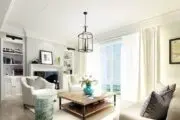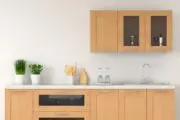A home isn’t just an investment or a place to grow roots with your family. There is growing awareness of the link between built environments and physical and mental health, giving momentum to the trend of wellness real estate and wellness-focused interior design.
Acknowledging the importance of the connection between design and well-being, here are some tips on how to use a wellness-focused interior design strategy to create a home that promotes mindfulness, reduces stress and enhances physical health.
Choose antibacterial materials
Cleanliness at home took on a different meaning during the pandemic, as we became acutely aware of how illnesses are transmitted, especially with high-touch surfaces.
Some materials have naturally germ-repellent qualities and are wise choices in areas such as bathrooms and kitchens to minimize bacteria and virus spread.
Copper as a pure metal can be nearly 100 percent effective at killing microorganisms, such as bacteria and others. Consider copper (or copper alloy blends) for sinks, fixtures, light switches, door handles, cabinet/drawer pulls and banisters to add bling and keep germs away.
Quartz is currently one the most sought-after countertop materials for its style quotient, but as a bonus, it is one of the most germ repellent, mostly because of its density.
Concealed storage to combat clutter
“Visual clutter can heighten our anxiety levels,” says WELL and LEED accredited interior designer Sarah Barnard.
“Built-in, concealed storage can be used to eliminate visual clutter and create a calmer space,” she says. If the budget allows, create custom storage to maximize functionality.
“Custom-designed storage can work with the realities of our daily routines and needs, creating a clutter-free space that is easy to maintain. This also reduces time spent on decision-making and tidying up, making space for activities that bring us joy,” says Barnard.
Opt for a green home
House hunters are increasingly prioritizing green home features, because of the financial benefits and for the sake of eco-conscience. Green home features create a more comfortable and health-focused living environment as well.
Some popular green home features include:
- High-efficiency appliances
- Air-tight envelope features (i.e. triple-pane windows, thicker doors, increased insulation).
- Low-flow or motion activated plumbing fixtures.
- Net-zero home with sustainable energy features or a regenerative home, where the home actually contributes to the eco-system it is built in, restoring the natural plant and/or wildlife habitat.
- Sustainable material choices are stylish and can help reduce homeowner footprint, such as bamboo, cork, reclaimed wood and wool.
Focus on restorative rest
Bedrooms are a basic part of home design, but is yours designed as a space to maximize restorative sleep, an essential cornerstone of health and well-being?
“A bedroom should be a sanctuary that creates a mindful, sensory experience,” says Barnard.
Invest in a high-quality mattress and comfortable bedding. Leave electronics out of the bedroom space, and try to keep the room on the cooler side
Additionally, Bernard recommends a custom weighted blanket.
“The quality of mass-produced weighted blankets can vary, often containing plastic poly pellets or glass beads. A custom sustainable weighted blanket allows the client to choose the fabric, color, interlining material, and weight,” she says.
Be aware of light and sound, both of which can interrupt sleep.
“High-pile carpeting or rugs insulate noise from hard flooring and deliver a softness underfoot. Layered window treatments can be used to block out the sun and create privacy,” says Barnard.
Barnard recommends a softer color palette to promote rest.
“Wall color is also an important consideration. Cooler or darker tones can be paired with soft, ambient lighting to create a cozy, cocoon-like atmosphere,” she says.
Improving indoor air quality
The air inside your home can become polluted with toxins and germs. The easiest way to improve your air quality is by increasing ventilation with outdoor air, which can be accomplished simply by opening a window. Ideally, you would open multiple windows in strategic locations to facilitate cross-ventilation.
Additionally:
- Install HEPA filters on the HVAC and change them monthly, or at a minimum quarterly. HEPA filters are effective in trapping undesirable particles as the air circulates.
- The use of UV lights with HVACs became more popular during the pandemic, as UV light is known to kill viruses and bacteria. People typically get a UV light attached to the HVAC itself, or in the ductwork.
- Portable air cleaners and purifiers can help, but these should play a supportive role only. They aren’t enough on their own to clean the air.
Spaces dedicated to fitness and recovery
Regular exercise is an essential part of good health. To get the most out of a home gym and to inspire motivation, homeowners should plan design strategically.
Homeowners often opt “for more subdued tones than commercial gyms”, says Tanya Ryno, designer and owner of Iron House . Beyond color palette, motivational artwork and décor themes can create the desired aesthetic.
Also important are “effective lighting, preferably natural, or bright, indirect artificial lighting, for a motivating atmosphere. Proper ventilation, possibly through fans or air conditioning, is essential for comfort. And storage solutions like shelving, cabinets, or built-in stations keep the gym organized and enhance its appearance,” says Ryno.
One of the most important, and often overlooked, aspects of gym planning is flooring, for injury prevention, noise cancelation and setting the style tone. Rubber is most common, with luxury plank vinyl trending too.
“It’s much easier than people think to put a proper gym floor in your home, and they can be any color under the rainbow. It does so much to make your space feel like a real gym,” says Evan Lyons, managing director, Ardent Fitness.
For contemplation and recovery, homeowners are valuing dedicated meditation spaces.
Saunas are becoming more popular as a recovery space and are becoming more affordable with lower price points over the last few years.
Saltwater pools are another sought-after at-home fitness feature.
Biophilic design
One of the hottest trends over the last few years is biophilic design, which centers on the concept that humans are innately drawn to the comforts of nature, even inside a built environment.
“Studies show the positive mental health benefits of spending time in nature. Biophilic design seeks to connect interior spaces to the landscape outside, mirroring the mindful experience of being in nature to create healing spaces where we can thrive in our homes,” says Barnard.
“Biophilic design can be incorporated into our homes in many ways, including patterns and color palettes from the natural world,” says Barnard.
- Use décor with curved lines or fractal patterns (naturally re-occurring patterns, such as a snowflake, a seashell or honeycomb). The visual predictability of these offers comfort.
- Utilizing a soft, earth-toned color palette can be soothing, with a focus on blues, greens, taupe and terracotta.
- Have large windows without treatments to foster an indoor/outdoor connection, and for natural light and to frame the view. Framing a view subconsciously suggests shelter, another comfort we seek in nature.









